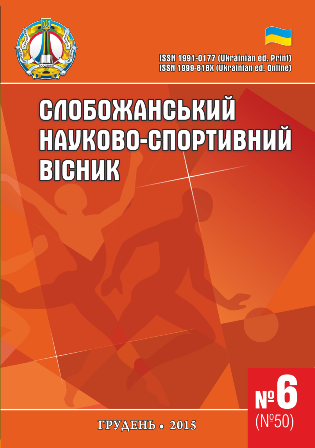Individual features of the physical development and the onset of biological maturity of morphological and functional structures of the body
DOI:
https://doi.org/10.15391/snsv.2015-6.001Keywords:
synchronization of interdependent relationships, individual rate, semantic feature space, similarity theory, prenosological forecastAbstract
Purpose: to justify the observed features of physical development of the individual and the nature of the flow pattern of biological maturity of morphological and functional structures of the body other than the population norm of behavior trends of these processes. Materials and Methods: analysis of scientific literature on the research, the use of survey data contingent of children of preschool and primary school age, the use of attributive semantic spaces, method of similarity and dimensions, the method of analogy, the method of slowly varying amplitudes. Results: the nature of occurrence of the individual characteristics of the physical development and the onset of biological maturity of morphological and functional structures of the whole organism. Substantiates the nature of occurrence of the individual variation of these processes. Conclusions: the existing differences in the individual development of physical and somatotype shaping involve a violation of the synchronization of interdependent relations system. This reduces the potential viability and is expressed in the constitution somatotype features that can be used for preclinical diagnosis.References
Blekhman I. I. Sinkhronizatsiya v prirode i tekhnike [Synchronization in nature and technology], Moscow, 1981, 352 p. (rus)
Samsonkin V. N., Druz V. A. Modelirovaniye v samoorganizuyushchikhsya sistemakh [Modeling in self-organizing systems], Donetsk, 2010, 104 p. (rus)
Shvanitskiy G. R. Ritmy razvivayushchikhsya slozhnykh system [Rhythms of developing complex systems], Moascow, № 9, 1988, 48 p. (rus)
Bekova D. B. Individualnaya anatomicheskaya izmenchivost organov, sistem i formy tela cheloveka [Individual anatomical variability of organs, systems and forms of the human body], Kiyev, 1988, 224 p. (rus)
Azhippo A. Yu., Dorofeyeva T. I., Puhach Ya. I., Artemyeva G. P., Nechitaylo M. V., Druz V. A. Slobozans’kij nauk.-sport. visn. [Slobozhanskyi science and sport bulletin], Kharkіv, 2015, № 5 (49), p. 13–23. (rus)
Volkenshteyn M. V. Obshchaya biofizika [General biophysics], Moscow, 1978, p. 408–418. (rus)
Gorban A. N. Demon Darvina, ideya optimalnosti i yestestvennyy otbor [The Demon Darwin, the idea of optimality and natural selection], Moscow, 1988, 208 p. (rus)
Azhippo A. Yu., Puhach Ya. I., Druz V. A., Zhernovnikova Ya. V. Slobozans’kij nauk.-sport. visn. [Slobozhanskyi science and sport bulletin], Kharkіv, 2015, № 4 (48), p. 7–14. (rus)
Azhippo A. Yu., Puhach Ya. I., Zhernovnikova Ya. V. Slobozans’kij nauk.-sport. visn. [Slobozhanskyi science and sport bulletin], Kharkіv, 2015, № 3 (47), p. 7–12. (rus)
Gika M. Estetika proportsiy v prirode i iskusstve [Aesthetics proportions in nature and art], Moscow, 1936, p. 163, 284, 285.
D-r H. V. Heller. Proportionstalekm der Menschlichen Gestalt, Vena, Izdaniye A.Shrollya, 1937. (rus)
Puhach Ya. I. Materialy 9-y mezhdunarodnoy nauchnoy prakticheskoy konferentsii «Bdeshcheto vprosi ot sveta na naukata», 2013, tom 39, Fizicheska kultura i sport [Proceedings of the 9th International Scientific and Practical Conference "Future issues of the world of science", 2013b, Volume 39, Physical Culture and Sport], Sofiya, p. 5–14. (rus)
Ashanin V. S., Puhach Ya. I. Postroyeniye semanticheskikh prostranstv dlya opisaniya psikhologicheskoy deyatelnosti cheloveka v ekstremalnykh usloviyakh [Building a semantic space to describe the psychological human activities in extreme conditions], Kharkov, 2014, 88 p. (rus)
Puhach Ya. I. Ekstremalnaya deyatelnost cheloveka: teoriya i praktika prikladnykh i ekstremalnykh vidov sporta [Extreme human activity: the theory and practice of applied and extreme sports], Moskva, 2013, № 3, p. 8–10. (rus)
Balsevich V. K. Ocherki po vozrastnoy kineziologii cheloveka [Essays on Human Kinesiology age], Moscow, 2009, 220 p. (rus)
Breytman M. Ya. Tablitsy dlya klinicheskoy antropometrii [Tables for Clinical anthropometry], Leningrad, 1926, 82 p. (rus)
Breytman M. Ya. Klinicheskaya semiotika i differentsialnaya diagnostika endokrinnykh zabolevaniy [Clinical Semiotics and differential diagnosis of endocrine diseases], Leningrad, 1949, 586 p. (rus)
Shustov S. B., Khalimov Yu. Sh., Trufanov G. Ye. Funktsionalnaya i topicheskaya diagnostika v endokrinologii [Functional and topical diagnostics in endocrinology], Sankt-Peterburg, 2010, 296 p. (rus)
Biryukova Z. I. (Kolarovoy) Fiziologiya rebenka rannego vozrasta [The physiology of a young child], Sofiya, 1970, 406 p. (rus)
Podrigalo L. V., Danilenko G. N. Donozologicheskiye sostoyaniya u detey, podrostkov i molodezhi: diagnostika, prognoz i gigiyenicheskaya korrektsiya [Prenosological condition in children, adolescents and young adults: diagnosis, prognosis and hygienic correction], Kiyev, 2014, 200 p. (rus)
Downloads
Published
How to Cite
Issue
Section
License
Copyright (c) 2015 (Oleksandr Aghyppo) Ажиппо Олександр Юрійович, (Valeriy Druz) Друзь Валерій Анатолійович, (Tatyana Dorofeeva) Дорофєєва Тетяна Іванівна, Yaroslavna Puhach Пугач Ярославна Ігорівна, (Nina Buren) Бурень Ніна Володимирівна, (Mariia Nechytailo) Нечитайло Марія Валеріївна, (Yana Zhernovnikova) Жерновнікова Яна Вікторівна

This work is licensed under a Creative Commons Attribution 4.0 International License.
Our publications make use of copyright CREATIVE COMMONS open access journals.
Authors published in this journal agree to the following terms:
1 The authors reserve the right of authorship of the work and pass the journal right of first publication of this work are licensed under the Creative Commons Attribution License, which allows others to freely distribute the published work with reference to the authors of the original work and the first publication of this magazine.
2 The authors have the right to enter into separate agreements for additional non-exclusive distribution of work in the form in which it was published the magazine (such as work place electronic repository institution or publish as part of the monograph), provided that the reference to the first publication of this magazine.

 Attention, authors!
Attention, authors!


